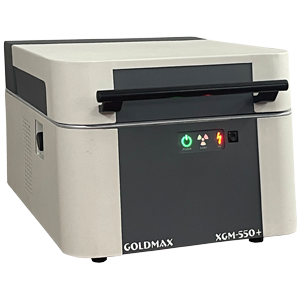Manufacturer And Exporter Of GOLDMAX ®XGM 550+

Highly accurate and dependable XRF machine designed for the analysis of precious metals such as gold
The invention of XRF (X-Ray Fluorescence) gold testing marked a significant advancement in the field of precious metal analysis. The initial development of XRF technology dates back to the early 20th century, but its application to gold testing gained prominence in the latter part of the century.
Invention and Early Development:
XRF spectroscopy as a concept was first introduced by Charles G. Barkla, a British physicist, in the early 1900s. He observed that when X-rays strike a material, the energy absorbed by the material can cause it to emit secondary X-rays or fluorescent X-rays. This phenomenon, known as X-ray fluorescence, demonstrated that the emitted X-rays carried information about the elemental composition of the material.
Application in Gold Testing:
The utilization of XRF technology for gold testing gained momentum in the latter half of the 20th century with the advent of more advanced equipment and the integration of computing technology. In the context of retail and jewelry, XRF gold testing was initially embraced by larger jewelry manufacturers, refiners, and assay labs due to the high cost and complexity of early XRF devices.
First Uses:
While there isn't a singular documented "first use" of XRF for gold testing, the technology gradually found its way into various industries, including jewelry manufacturing, refining, and precious metal trading. As the technology evolved and became more accessible, it eventually reached retail settings where jewelers and pawnshops could employ XRF devices to assess the purity of gold items.
Significance:
The adoption of XRF gold testing not only enhanced the efficiency of gold analysis but also provided a more objective and reliable means of determining the purity of gold. It enabled retailers to provide customers with transparent and trustworthy information about their gold items, fostering greater confidence in transactions.
In conclusion, the invention and subsequent application of XRF technology for gold testing transformed the way the precious metal industry operates, offering a faster, more accurate, and non-destructive method for assessing the quality of gold items in retail and various other sectors.
The invention of XRF (X-Ray Fluorescence) gold testing in retail has revolutionized the way precious metal testing is conducted, particularly in the context of gold. XRF technology offers a significant improvement over traditional testing methods, providing various advantages that enhance accuracy, efficiency, and convenience.
Advantages of XRF Gold Testing
Non-Destructive
Unlike traditional methods that may require sample destruction, XRF testing is non-destructive. It doesn't damage the jewelry or precious metal item being tested.
Rapid Results
XRF provides near-instant results, allowing retailers to quickly verify the purity of gold items and offer prompt information to customers.
High Accuracy
XRF technology offers precise elemental analysis, providing detailed information about the composition of the gold, including trace elements and impurities.
Minimal Operator Skill
Operating XRF devices requires less specialized skill compared to complex techniques like fire assay. Retail staff can be trained relatively easily to use XRF equipment effectively.
Objective Measurements
XRF results are objective and less influenced by subjective interpretation, reducing the likelihood of errors caused by human factors.
Wide Range of Elements
XRF can analyze a wide range of elements simultaneously, making it suitable for testing different types of alloys and materials.
Data Logging and Reporting
XRF devices often come with software that allows for data logging, creating detailed reports for record-keeping and transparency.
User-Friendly
Modern XRF machines are designed with user-friendly interfaces, simplifying the testing process and reducing the learning curve.
